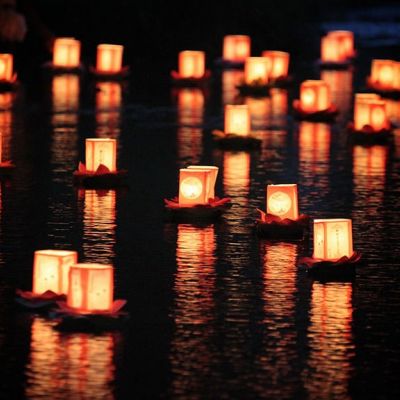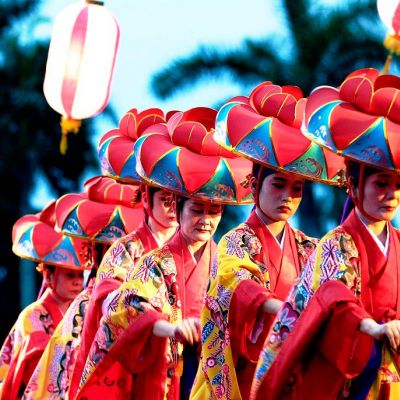Obon festival (also known as Bon festival) is an annual Japanese celebration that honors and recalls dead ancestors. It is thought that their ghosts return at this time to visit their loved ones. Obon is a blend of old Japanese belief in ancestral spirits with a Japanese Buddhist ritual of honoring one’s forebears. It has been celebrated in Japan for almost 500 years and customarily involves a dance called Bon Odori.
Bon, also known as Obon, is a prominent Japanese holiday observed every July (or, in some places, August). Influenced by the Buddhist All Souls Day, when the dead return to the world of the living, Bon is a time for visiting and cleaning gravestones, as well as burning lights to guide the spirits of departed ancestors home. Bon is also a time when families and communities congregate.
Obon Festival Origin
This Buddhist celebration has been held for over 500 years. It is based on the Maha Maudgalyayana (Mokuren) tale. He was a Buddhist student who utilized his abilities to glimpse the ghost of his late mother. He learned she had slipped into the Realm of Hungry Ghosts and was in distress. Buddha instructed Mokuren to provide contributions to Buddhist monks. On the 15th day of the seventh month, he followed Buddha’s instruction, and his mother was relieved of her sorrow. Mokuren danced with delight, which is the source of the Obon dance.

Obon Festival Traditions and Celebrations
Obon is celebrated with a variety of rituals and celebrations. These might differ from area to region and from family to family. People traditionally spend time cleaning their ancestors’ graves, as well as participating in dances, festivals, and other activities.
Toro Nagashi
Toro Nagashi is floating lanterns that are customarily carried down a river that flows into the sea. These lanterns reflect ancestors’ spirits and are a symbolic method to honor loved ones and family members who have gone away. Each toro nagashi has a little candle, which lights the paper lanterns as they float downstream.
Bon Odori
Bon Odori is a traditional dance performed to commemorate the Obon Festival. While performances vary greatly from area to region, the dance is generally accompanied by Japanese taiko drums and performed by performers dressed in yukata. Anyone is invited to participate in the dance, which is commonly held in parks, temples, shrines, and other public spaces.
When Is Obon?
Obon celebration dates vary by area in Japan, depending on whether communities use a solar or lunar calendar to record certain festivals. While Japan formerly used a lunar calendar to mark time, they transitioned to the more popular Gregorian calendar at the start of the Meiji period. Since then, various parts of Japan have continued to observe holidays using a variety of calendar systems. The Obon Festival is often held around July 15 of the lunar calendar and lasts four days, from August 13 to 16. The date may alter somewhat in different parts of Japan, such as Okinawa, where the Obon will occur from August 28 to 30, 2024.
How To Celebrate The Obon Festival?
Making Offerings and Sweeping Tombs: Day 1
Making food offerings is a key part of the Bon celebration. The most prominent offering is Syouryouuma, or animal figurines. It is constructed of cucumber or eggplant and has four bamboo sticks shaped like cattle or horses. This unique contribution is supposed to represent transportation, which refers to spirits going between Earth and the underworld.
Bon Odori Dances: Day 2
Bon Odori, a traditional Japanese folk dance, is a must-see during the Obon Festival. Odori, which began as a separate Buddhist custom, has now evolved into a massive summer celebration across Japan. The traditional practice is undertaken to appease and highlight the spirits of ancestors. The dance occurs in a variety of settings, including gardens, parks, shrines, and temples.
Chochin Lantern Floating, Day 3
Japanese folks make Chochin lanterns (toro nagashi) in addition to Oban lanterns, which are hung outside houses and along the streets. It has become a popular and spectacular method to greet and bid goodbye to ancestors. It is thought that the ghosts of their ancestors may be sent into the sky by floating lanterns down a river to sea.

Obon Festival In Other Countries
Obon Festival has inspired similar celebrations around the world:
- In the Philippines, To celebrate their ancestors and Japan’s goodwill, Filipinos of Japanese origin in the Philippines hold the Obon festival each year, which is sponsored by groups such as Philippine Nikkei Jin Kai Inc., Philippine Nikkei Jin Kai International School, and Mindanao Kokusai Daigaku.
- In Argentina, Japanese communities celebrate the Obon Festival during the southern hemisphere’s summer season. The largest event is place at Colonia Urquiza, La Plata.
- Every year, various Japanese communities around Brazil celebrate the Obon Festival, since Brazil has the biggest Japanese population outside of Japan. São Paulo is the primary city of the Japanese community in Brazil and hosts the largest event, which includes street odori and matsuri dancing.
- Every year in Malaysia, the Obon Festival is held in Esplanade in Penang, Shah Alam Stadium in Shah Alam, Selangor, and Universiti Malaysia Sabah in Kota Kinabalu, Sabah. The Japanese Expatriate & Immigrant Society in Malaysia created this festival, which has become a prominent attraction in the state of Selangor.
- Obon celebrations are also celebrated in North America, especially by Japanese-Americans and Japanese-Canadians who belong to Buddhist temples and organizations. Obon Festival is traditionally celebrated by Buddhist Churches of America (BCA) temples in the United States, with both religious Obon observances and traditional Bon Odori dance around a yagura.
Where can I attend the Obon Festival?
The Bon Festival is a massive feast across Japan. Each area has its unique traditions and rituals for honoring the spirits of their ancestors. Tokyo, Sasebo, and Tokushima are three suggested places for a complete Obon experience.
